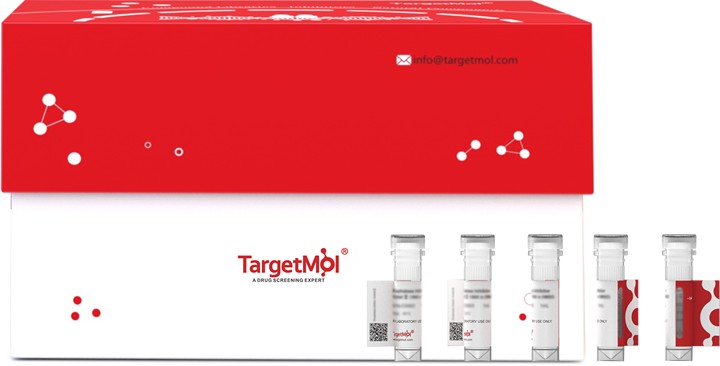- Remove All
 Your shopping cart is currently empty
Your shopping cart is currently empty
HBP1 Protein, Human, Recombinant (GST)
HBP1 is a sequence-specific DNA-binding transcription factor. It is involved in many biological processes. It was reported that HBP1 binds to p16(INK4A) promoter and activates p16(INK4A) expression. We found that trichostatin A (TSA), an inhibitor of HDAC (histone deacetylase), induces p16(INK4A) expression in an HBP1-dependent manner. HBP1 activates or represses the expression of some specific genes during cell growth and differentiation. HBP1 was acetylated by p3/CBP in two regions: repression domain (K297/35/37) and P domain (K171/419). HBP1 acetylation after TSA treatment was confirmed by immunoprecipitation assay. HBP1 interacted with histone acetyltransferase p3 and CREB-binding protein (CBP) and also recruited p3/CBP to p16(INK4A) promoter. HBP1 acetylation at K419 plays an important role in HBP1-induced p16(INK4A) expression.

HBP1 Protein, Human, Recombinant (GST)
| Pack Size | Price | Availability | Quantity |
|---|---|---|---|
| 100 μg | $700 | 7-10 days |
Product Information
| Biological Activity | Activity testing is in progress. It is theoretically active, but we cannot guarantee it. If you require protein activity, we recommend choosing the eukaryotic expression version first. |
| Description | HBP1 is a sequence-specific DNA-binding transcription factor. It is involved in many biological processes. It was reported that HBP1 binds to p16(INK4A) promoter and activates p16(INK4A) expression. We found that trichostatin A (TSA), an inhibitor of HDAC (histone deacetylase), induces p16(INK4A) expression in an HBP1-dependent manner. HBP1 activates or represses the expression of some specific genes during cell growth and differentiation. HBP1 was acetylated by p3/CBP in two regions: repression domain (K297/35/37) and P domain (K171/419). HBP1 acetylation after TSA treatment was confirmed by immunoprecipitation assay. HBP1 interacted with histone acetyltransferase p3 and CREB-binding protein (CBP) and also recruited p3/CBP to p16(INK4A) promoter. HBP1 acetylation at K419 plays an important role in HBP1-induced p16(INK4A) expression. |
| Species | Human |
| Expression System | E. coli |
| Tag | N-GST |
| Accession Number | O60381-1 |
| Synonyms | HMG-box transcription factor 1 |
| Construction | A DNA sequence encoding the mature form of human HBP1 (O60381-1) (Pro208-Phe345) was fused with the GST tag at the N-terminus. Predicted N terminal: Met |
| Protein Purity | > 95 % as determined by SDS-PAGE |
| Molecular Weight | 42.5 kDa (predicted); 43 kDa (reducing conditions) |
| Endotoxin | Please contact us for more information. |
| Formulation | Lyophilized from a solution filtered through a 0.22 μm filter, containing PBS, pH 7.4. Typically, a mixture containing 5% to 8% trehalose, mannitol, and 0.01% Tween 80 is incorporated as a protective agent before lyophilization. |
| Reconstitution | A Certificate of Analysis (CoA) containing reconstitution instructions is included with the products. Please refer to the CoA for detailed information. |
| Stability & Storage | It is recommended to store recombinant proteins at -20°C to -80°C for future use. Lyophilized powders can be stably stored for over 12 months, while liquid products can be stored for 6-12 months at -80°C. For reconstituted protein solutions, the solution can be stored at -20°C to -80°C for at least 3 months. Please avoid multiple freeze-thaw cycles and store products in aliquots. |
| Shipping | In general, Lyophilized powders are shipping with blue ice. |
| Research Background | HBP1 is a sequence-specific DNA-binding transcription factor. It is involved in many biological processes. It was reported that HBP1 binds to p16(INK4A) promoter and activates p16(INK4A) expression. We found that trichostatin A (TSA), an inhibitor of HDAC (histone deacetylase), induces p16(INK4A) expression in an HBP1-dependent manner. HBP1 activates or represses the expression of some specific genes during cell growth and differentiation. HBP1 was acetylated by p3/CBP in two regions: repression domain (K297/35/37) and P domain (K171/419). HBP1 acetylation after TSA treatment was confirmed by immunoprecipitation assay. HBP1 interacted with histone acetyltransferase p3 and CREB-binding protein (CBP) and also recruited p3/CBP to p16(INK4A) promoter. HBP1 acetylation at K419 plays an important role in HBP1-induced p16(INK4A) expression. |
Dose Conversion
Calculator
Tech Support

Copyright © 2015-2025 TargetMol Chemicals Inc. All Rights Reserved.


